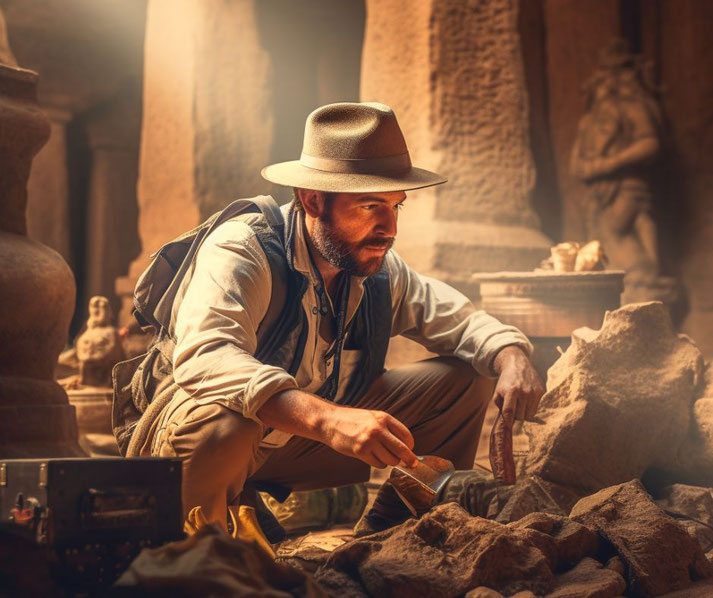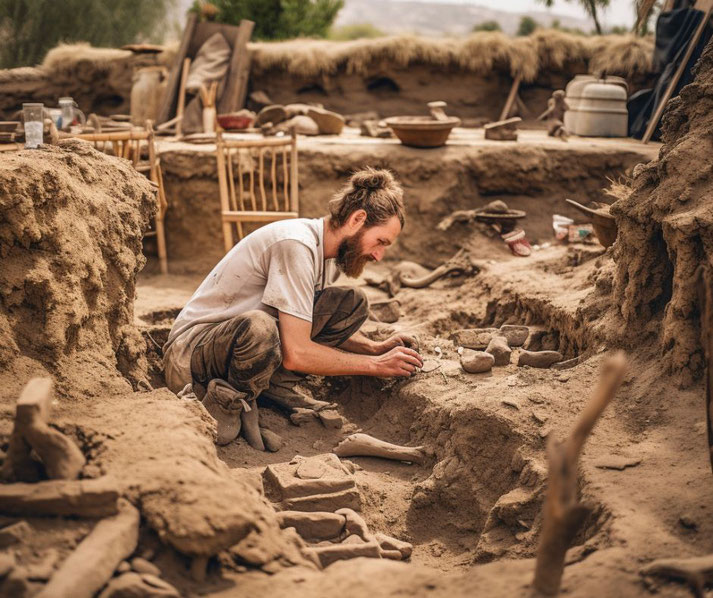How archaeologists dig deep to unearth our human story

Buried beneath the surface of the ground in our bustling modern world lie ancient secrets waiting to be unveiled. Every artefact that is unearthed hold rare information about past civilizations past, the personal struggles of the people who lived in them, and rare glimpses into their daily lives.
However, in order to find these rare and fragile items, they have to be carefully removed through the process of an archaeological excavation.
It is the job of archaeologists to patiently remove each layer of soil to reveal each artefacts without damaging them forever.
But how exactly do archaeologists approach an excavation?
How do they interpret the tiny remains of the past that they uncover?
And how do other scientific disciplines contribute to these interpretations?
What is an archaeological excavation?
An archaeological excavation is a process of uncovering and documenting the material remains of past human activities.
It involves the careful removal of soil and other deposits from a site, the recording of the location and context of the artifacts and features found, and the analysis and interpretation of the data collected.
Archaeological excavation can be conducted for various purposes, such as scientific research, cultural heritage preservation, or public education.
This process can reveal information about the history, culture, technology, and environment of ancient societies.
A brief history of excavation
The practice of excavation dates back to antiquity, but it was not until the 19th century that it began to resemble what we now consider professional archaeology.
In the early days, excavation was often just a simple treasure hunt, with individuals searching for spectacular artifacts with minimal concern for the context in which they were found.
Then, the pioneering archaeologist, Flinders Petrie, introduced the principle of stratigraphy to excavation, which had been developed by geologist William Smith in the early 19th century.
It was Petrie that recognized that it could be used for historical artifacts within a site, which could be dated relative to each other by the layer of earth in which they were found.
In the 20th century, archaeologists like Mortimer Wheeler further refined excavation methods, promoting systematic techniques and a more scientific approach.
Today, archaeological excavations are highly organized, meticulously planned, and heavily reliant on a wide array of sciences, including chemistry, geology, physics, and biology.

The process of excavation
1. Planning
A well-executed excavation begins with careful planning. It's a process that requires research and often involves initial non-invasive site surveys to get an understanding of what lies beneath the surface.
Techniques such as aerial photography, ground-penetrating radar, and LiDAR can provide invaluable information about a site before a single shovel touches the earth.
Aerial photographs
This method uses images captured from the air to reveal archaeological features that might not be visible from the ground level.
These could include ancient roadways, building foundations, or patterns of vegetation growth that might hint at buried structures or artifacts.
Aerial photography allows for a larger perspective of the landscape and can provide an overall context of an archaeological site before detailed excavation begins.
It can also reveal sites that are not immediately apparent on the ground. With the advent of drones, aerial photography has become even more accessible and customizable.
Ground-penetrating radar (GPR)
GPR is a non-invasive geophysical method that uses radar pulses to detect and map subsurface features.
This technique is used in archaeology to detect and map subterranean artifacts, features, and patterning.
GPR can help determine the depth and layout of archaeological remains and inform the planning of targeted excavation strategies.
It is particularly useful because it can reveal the depth, size, and configuration of buried archaeological features without any excavation at all.
LiDAR
LiDAR, which stands for Light Detection and Ranging, is a remote sensing technology that uses light in the form of pulsed laser to measure variable distances from the Earth’s surface to the sensor.
These light pulses—combined with other data recorded by the airborne system— generate precise, three-dimensional information about the shape of the Earth and its surface characteristics.
In archaeology, LiDAR is often used to create high-resolution digital models of the landscape, which can reveal hidden archaeological features such as building foundations, roadways, or even entire city layouts that are not visible from the ground, particularly in areas with dense vegetation.
2. Stratigraphic excavation
Once on site, archaeologists rely heavily on the principles of stratigraphy, the study of layered sedimentation.
Over time, layers of soil (or strata) accumulate, with older layers generally beneath the newer ones.
By carefully removing these layers one at a time, archaeologists can piece together a chronological sequence of occupation and use.
3. Recording and mapping
As they excavate, archaeologists meticulously record the position of artifacts, features, and stratigraphic units in the site.
This information provides the context for the artifacts, an element crucial for understanding their function, significance, and chronological placement.
The archaeological record consists of field notes, photographs, drawings, and increasingly, digital data.

4. Artefact analysis
Artifacts, ecofacts, and other archaeological materials are typically sent to a lab for further analysis after being extracted.
Through various analytical techniques, archaeologists can learn more about the objects' age, composition, and usage, and perhaps even glean some insights into the people who made and used them.
When to call in additional experts
The interpretation of archaeological findings often requires input from various experts from a wide range of disciplines.
Since archaeologists are not trained in all of the different ways that items can be studied, it is often important to call in others who have these tkills.
Here's how each specialist can contribute to understanding the results of an excavation:
Anthropologists
Anthropologists can provide valuable insights into the social, cultural, and biological aspects of the people who once inhabited an archaeological site.
They can interpret human remains, tools, artifacts, and other signs of human activity.
This allows them to place these findings within the broader context of human behavior, culture, and evolution.
Epigraphers
Epigraphers specialize in the study of inscriptions or epigraphs. They can decipher, interpret, and date inscriptions found on artifacts or architectural fragments.
Ancient inscriptions can be in any one of hundreds of different languages.
The work of epigraphers can therefore provide important information about the language, scripts, customs, and historical events of the society under study.
Forensic pathologists
Forensic pathologists can examine human remains to determine the cause and manner of death, age at death, sex, and other details about individuals' lives.
They are experts in how a person died: whether by natural or violent means. The clues left on a body are often very small and requires a trained eye to find.
In archaeological contexts, their skills can help build a clearer picture of past populations' health, lifestyles, and causes of death.
Papyrologists
Papyrologists study ancient literature, correspondence, legal archives, etc., preserved on papyrus or similar materials.
They can help translate, interpret, and preserve these delicate documents, potentially revealing valuable historical and cultural information.
Radiologists
In archaeology, radiologists often work with other specialists to perform and interpret imaging studies on archaeological materials, such as mummies, bones, or other artifacts.
Techniques such as CT scans or X-rays can reveal hidden features or internal structures without damaging the artifact.
Ceramists
Ceramicists are experts in pottery and other ceramic artifacts. They can provide insights into the manufacture, use, and symbolic meaning of pottery, and even establish chronologies based on pottery styles and technologies.
Climatologists
Climatologists study past climate conditions, which can be critical for understanding the environmental context of an archaeological site.
Information about past climate can shed light on agricultural practices, habitation periods, and potentially even the rise or fall of the societies under study.
Vulcanologists
Vulcanologists study volcanoes and volcanic phenomena. In archaeology, they can contribute to understanding natural events that may have affected ancient societies, such as volcanic eruptions that buried cities (like Pompeii), or the use of volcanic materials in construction or craftsmanship.
The impacts of excavations
While excavation provides an incredible wealth of information about past societies, it is a destructive process.
Once a site is excavated, it can never be returned to its original state. As such, it is the ethical responsibility of archaeologists to minimize unnecessary destruction and ensure the valuable data from every excavation is preserved and shared for future generations.
The science of archaeology has come a long way since the treasure-hunting days of the past.
Today, excavations are complex, multidisciplinary endeavors that enable us to step back in time and glimpse the lives of those who came before us.
Through careful planning, stratigraphic excavation, meticulous recording, and thorough artifact analysis, we continue to uncover the complex story of human history, one layer at a time.

What do you need help with?
Download ready-to-use digital learning resources
Copyright © History Skills 2014-2025.
Contact via email
With the exception of links to external sites, some historical sources and extracts from specific publications, all content on this website is copyrighted by History Skills. This content may not be copied, republished or redistributed without written permission from the website creator. Please use the Contact page to obtain relevant permission.





